Advertisements
Advertisements
प्रश्न
In the Figure, `square`ABCD is a trapezium. AB || DC. Points P and Q are midpoints of seg AD and seg BC respectively. Then prove that, PQ || AB and PQ = `1/2 ("AB" + "DC")`.
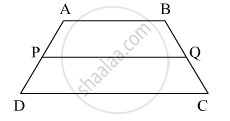
उत्तर
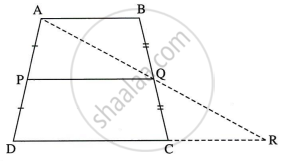
Given: `square`ABCD is a trapezium.
To prove: PQ || AB and PQ = `1/2`(AB + DC)
Construction: Extend line AQ in such a way that, on extending side DC, intersect it at point R.
Proof:
seg AB || seg DC ...(Given)
and seg BC is their transversal.
∴ ∠ABC ≅ ∠RCB ...(Alternate angles)
∴ ∠ABQ ≅ ∠RCQ ...(i) ...(B-Q-C)
In ∆ABQ and ∆RCQ,
∠ABQ ≅∠RCQ ...[From (i)]
seg BQ ≅ seg CQ ...(Q is the midpoint of seg BC)
∠BQA ≅ ∠CQR ...(Vertically opposite angles)
∴ ∆ABQ ≅ ∆RCQ ...(ASA test)
seg AB ≅ seg CR ...(c.s.c.t.) ...(ii)
seg AQ ≅ seg RQ ...(c.s.c.t.) ...(iii)
In ∆ADR,
Point P is the midpoint of line AD. ...(Given)
Point Q is the midpoint of line AR. ...[From (iii)]
∴ seg PQ || side DR ...(Midpoint Theorem)
∴ seg PQ || side DC ...(iv) ...(D-C-R)
∴ side AB || side DC ...(v) ...(Given)
∴ seg PQ || side AB ...[From (iv) and (v)]
PQ = `1/2` DR ...(Midpoint Theorem)
= `1/2` (DC + CR)
= `1/2` (DC + AB) ...[From (ii)]
∴ PQ = `1/2` (AB + DC)
APPEARS IN
संबंधित प्रश्न
ABCD is a trapezium in which AB || DC, BD is a diagonal and E is the mid-point of AD. A line is drawn through E parallel to AB intersecting BC at F (see the given figure). Show that F is the mid-point of BC.
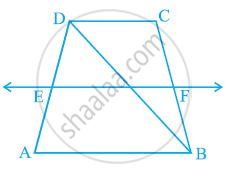
ABC is a triangle right angled at C. A line through the mid-point M of hypotenuse AB and parallel to BC intersects AC at D. Show that
- D is the mid-point of AC
- MD ⊥ AC
- CM = MA = `1/2AB`
ABCD is a kite having AB = AD and BC = CD. Prove that the figure formed by joining the
mid-points of the sides, in order, is a rectangle.
In the below Fig, ABCD and PQRC are rectangles and Q is the mid-point of Prove thaT
i) DP = PC (ii) PR = `1/2` AC
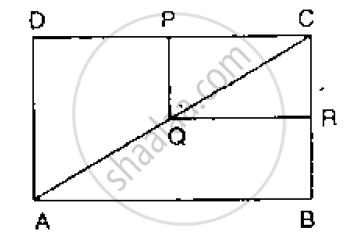
ABCD is a quadrilateral in which AD = BC. E, F, G and H are the mid-points of AB, BD, CD and Ac respectively. Prove that EFGH is a rhombus.

In parallelogram ABCD, E and F are mid-points of the sides AB and CD respectively. The line segments AF and BF meet the line segments ED and EC at points G and H respectively.
Prove that:
(i) Triangles HEB and FHC are congruent;
(ii) GEHF is a parallelogram.
In triangle ABC, D and E are points on side AB such that AD = DE = EB. Through D and E, lines are drawn parallel to BC which meet side AC at points F and G respectively. Through F and G, lines are drawn parallel to AB which meets side BC at points M and N respectively. Prove that: BM = MN = NC.
In ΔABC, D is the mid-point of AB and E is the mid-point of BC.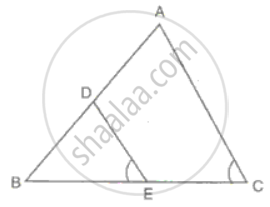
Calculate:
(i) DE, if AC = 8.6 cm
(ii) ∠DEB, if ∠ACB = 72°
Prove that the straight lines joining the mid-points of the opposite sides of a quadrilateral bisect each other.
In ΔABC, D, E and F are the midpoints of AB, BC and AC.
If AE and DF intersect at G, and M and N are the midpoints of GB and GC respectively, prove that DMNF is a parallelogram.
